People’s Liberation Army (PLA)
Around 25,000 armored military vehicles
Tanks
Prototypes & Projects
Fake Tanks
Chinese Vehicles in Foreign Service
Context before 1949 (1937-1945)
After the fall of the Empire and Qing dynasty in 1912, the first Chinese Republic was born. Sun Yat-sen was its first president, but he was forced to give way to the former dynasty army general, Yuan Shikai. After the troubled Era of the Warlords, Sun protégé, Chiang Kai-shek, formed the Kuomintang in the south, rallying most of south and central China in the 1926–1927 campaign. By 1934, the opposing force, the Communist Party of China, took refuge in the mountains. After being driven out, the Chinese Soviet Republic started its famous “long march” to the northwest, establishing a guerilla base at Yan’an in the Shaanxi Province around their new leader, Mao Zedong.
From 1931 on, these two forces would collide until a formal agreement was established in order to try to repel the Japanese Invasion started at Shanghai. The Sino-Japanese War ended in 1945, and the old rivalry bewteen Chiang Kai-shek’s Kuomintag and the Communist movement led by Mao reappeared.
At the start of the war with Japan in 1937, the Nationalists led by Chiang Kai-shek had support from the European powers and especially Germany, which sold them various military equipment and weapons, including some armored cars. However, the bulk of Chinese armor consisted of L3 tankettes purchased from Italy, along with a few amphibious Vickers tankettes and a few Vickers 6-ton tanks.
This was not sufficient against the Japanese. With World War Two erupting, the relations were reversed due to the German-Japanese alliance. Little support could be given except for a single American squadron (Chennault’s famous Flying Tigers) until Pearl Harbor changed it all. After this point, American support to the Nationalist side began to weigh heavily. By 1944, the Nationalist forces were well equipped with M5 Stuart and M4 Sherman tanks, whereas the CPC gradually started receiving some military help by USSR.
The bloody civil war which resulted after the Japanese surrender ended in 1949 with a total victory for the CPC. The Nationalists were driven back to a few islands around Taipei (Taiwan), which consolidated into the Republic of China, in opposition to the People’s Republic of China on the mainland. Tanks used by the PRC included the Gongchen (a Type 97 Chi-Ha), T-34/85s, IS-2 heavy tanks, and some captured vehicles.
The People’s Liberation Army
The People’s Liberation Army was founded in August 1927, during the Nanking Uprising. It fought off against several expeditions by the Kuomintang and also fought against the Japanese. Thus, in 1949, when China fell entirely under the control of the PRC, the army had long years of experience, both against the Nationalists and the Japanese. By 1949, the army was reorganized into three branches, the People’s Liberation Army Ground Force (PLAGF), Navy and Air Force.
The bulk of the tank forces and armored divisions is ensured by a core of professional volunteers, while the infantry consists of conscripts, as military service is compulsory. In the case of a national emergency, these forces would be supplemented by the People’s Armed Police and the People’s Liberation Army Militia acting as a reserve. The military age is between 18 and 49 years and both men and women are considered fit for military service. This gives a total of 385 million men and 363 million women able to be called under arms. The military budget as a whole is about 1.4% (2014 est.) of the GDP.
Development of domestic armor
The Norinco Corporation (China North Industries Corporation) is now the leading Chinese supplier of tanks and armored vehicles but also focuses on small arms. The bulk of the production facilities is located at the Inner-Mongolia First Machine Group Company Limited since the 1950s. These facilities started with Soviet-supplied parts and equipment, with the goal of building the first proper Chinese tank, the Type 58. None were built, however. In order to have access to better tanks, the Sino-Soviet Treaty of Friendship and military alliance was signed in 1956. With it, a factory was built in Mongolia, Factory 617/Baotou Tank Plant, later known as the Inner-Mongolia First Machine Group Company Limited.
The complex was a copy of a manufacturing plant producing the T-54. This complex delivered the Type 59, by far the most produced Chinese tank up to this point. The Type 59 not only formed the backbone of Chinese armored divisions until the 1980s, but was also the basis upon which virtually all other Chinese tanks were designed. These include the light Type 62, the Type 69 and 79, and even the Type 80, 85 and 88. This reliance on the T-54A and not the newer Soviet MBTs built in the meantime, like the T-62, T-64 and T-72, was due to the severing of relations with the Soviet Union in the 1960s. This not only meant that China was cutoff from Soviet tank improvements, but it also had to, in the long run, rely more extensively on Western technology, ending with the strange mix of Soviet and Western designs which characterize the Type 90, 98 and 99.
Military operations
The Korean War (1951-54)
The Soviet Union gave China 1,837 T-34/85 tanks, which also served with the North Koreans during the Korean War. The 1954 Operations Research Office report of “Tank v Tank Combat in Korea” stated that there had been 119 tanks duels in the Korean War, including 38 US tanks lost against T-34s (some were repaired afterward). The Chinese records allegedly claimed a number of US tanks later in the war, at a time when the bulk of the North Korean T-34s (over 400 estimated) had already been lost by November 1950.
In any case, records of Chinese Type 58 tanks operating in Korea have been confirmed. It should be also noted that North Korean forces operated SU-76 self-propelled guns, which were highly useful as the mountainous terrain that hosted most of the engagements was not fit for large tank assaults. The job was done by mortars, artillery, and infantry, for which the tanks only served as a support, dealing with fortified positions, a task they were not fit for due to their relatively small-caliber hard-hitting rounds rather than High Explosive ones. After the war, a Sino-Soviet agreement saw the construction of a large manufacturing complex to deliver a copy of the T-54A which became until the 2000s, Chinese reference MBT.
![]()
Destroyed Chinese T-34/85, Korean War.
Sino-Indian War (1962)
This fast clash of Asian titans lasted between 20 October and 21 November 1962 but was quite intense. Set on the Himalayan border, this conflict had deep and complex roots, including the 1959 Tibetan revolt, in which India had granted asylum to the Dalai Lama, and the erection of a line of defensive works to the north of the McMahon Line, a territory claimed by 1st Chinese minister Zhou Enlai in 1959. Unable to reach an agreement, Chinese PLA forces launched an all-out offensive against Indian positions along the Mac Mahon line, but concentrating on Ladakh.
The Air Force took no part in it, due to the altitude and bad weather. There are no accounts of any armored vehicles being involved on either side due to the nature of the terrain, but SPGs were employed for support. Despite heavy losses on both sides and hazardous claims, China mostly secured its objectives and took de facto control of the Aksai Chin.
Sino-Soviet border conflict (1969)
Distrust seeped into Sino-Soviet relations, eventually leading to a major fracture in the Communist world, as well as a swapping of alliances (which was more obvious after Deng Xiaoping’s visit to the USA 1979). This seven-month undeclared military conflict erupted on the border between the two countries at the height of the Sino-Soviet split. It concentrated on the disputed areas near the Argun and Amur rivers and saw at least one tank engagement. On March 2, 1969, PLA’s troops ambushed a Soviet border guard unit on Zhenbao Island.
59 soldiers were killed dead and, on March 15, the Soviet commander ordered a retaliatory artillery strike on a Chinese troop concentration while Zhenbao Island was re-taken. Afterward, four of the brand new T-62 MBTs were sent to deal with Chinese patrols on the island. However, one of these vehicles was hit and never recovered due to accurate Chinese artillery fire. It was captured afterwards and proved instrumental in allowing the Chinese to reverse-engineer the latest Soviet technology and devise the next generation of MBTs, the Type 69/79.
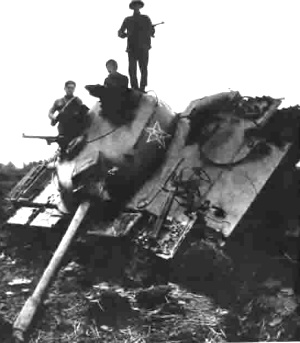
Type 59 from the 8th Army destroyed in 1979
Sino-Vietnamese border conflict (1979)
A part of the “Third Indochina war”, this obscure border conflict lasted from February 17 to March 16, 1979. The roots of the conflict can be found in the Soviet Union and Vietnam twenty-five year mutual defense treaty, the war against the Khmer Rouge of Cambodia, alleged mistreatment of Vietnam minorities and the Spratly Islands claimed by China. This time, the Chinese fielded a massive force of some 200,000 PLA infantry well supported by some 400-550 tanks. Opposing them were 70,000–100,000 regular Vietnamese force and some 150,000 local troops and militia. The terrain, again, was mountainous and difficult for tanks. The Chinese losses due to RPGs were massive. The first assault on February, 17, saw 200 Type 59, Type 62, and Type 63 tanks engaged in support of the infantry divisions. A pincer movement was launched, towards the west, aimed at Cao Bang, Lang Son and Quang Ninh Provinces, and the east, towards Ha Tuyen, Hoang Lien Son and Lai Chau Provinces.
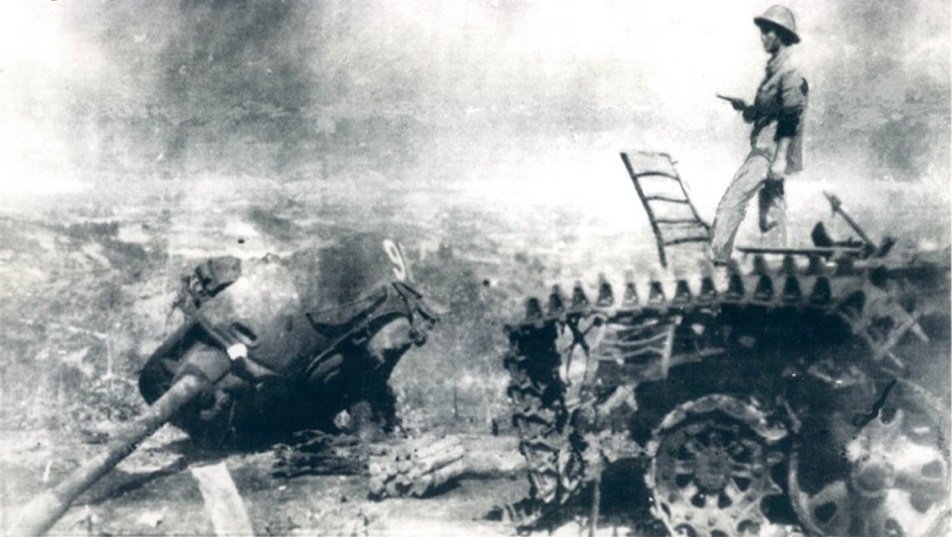
Type 62 destroyed at Cao Bang.
All Vietnamese forces from Cambodia, southern Vietnam and central Vietnam were deployed to the northern border while the USSR provided intelligence and equipment support. The Soviet Pacific Fleet provided battlefield communication relays. What followed were the First Battle of Lang Son, Battle of Dong Dang, Battle of Lao Cai and Battle of Cao Bang, which saw the Vietnamese inflicting massive casualties on the attacking Chinese. Depending on the sources, Chinese casualties ranged from 9,000 (Chinese claim) to 62,500 plus 550 military vehicles and 115 artillery pieces destroyed (Vietnam claim) while about 117 000 Vietnamese troops and militias were claimed by the Chinese plus 10,000 civilians.
In the aftermath, not only did Vietnam consider the war a clear-cut victory against an invader, but this also allowed the Soviets to continue backing the Vietnamese in a war to defeat Pol Pot in Cambodia, ending a tragic genocide. The war was not over, with border skirmishes erupting throughout the 1980s, starting with the Shelling of Cao Bằng, the 1981 Battle of Mẫu Sơn, and the 1984 Battle of Vị Xuyên. Border shellings were discontinued until 1988 but an uneasy ceasefire and border pact were ultimately signed in 1999.
Mediums & MBTs: From the Type 58 to the Type 99
Type 58 (1952)
The Type 58 is often claimed to be the first Chinese-built tank, a simple copy of the Soviet T-34/85. However, all the Type 58s used by the PLA were Soviet-built. It is highly possible that the Chinese did indeed plan to build a copy of the T-34/85, but switched to the Type 59 instead. The Type 58s received several upgrades that make them distinctive.
Type 59 MBT (1958)
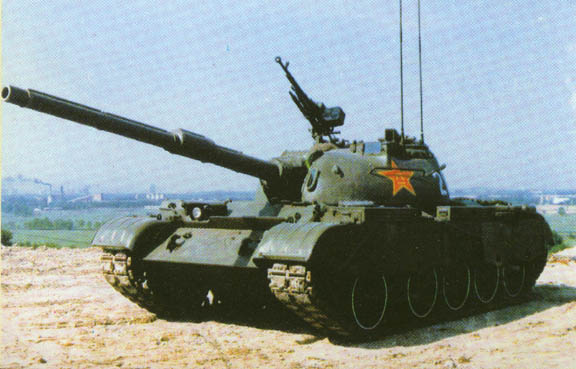
The Type 59 was the most numerous Chinese battle tank, at least until the 1990s. 9500 units were produced, modernized in several series, from the I to the II and IIA. The lastest versions are still in service today. The main change involved the replacement of the original Soviet-copied 100 mm (3.94 in) gun with a British-licenced version of the L7 gun. The Type 59 was basically a copy of the T-54A, produced with Soviet help just before the relations with the USSR were severed. This model was also largely exported.

Type 59 MBT, early production, 1958.

Congolese Type 59 in operations, 1980s.
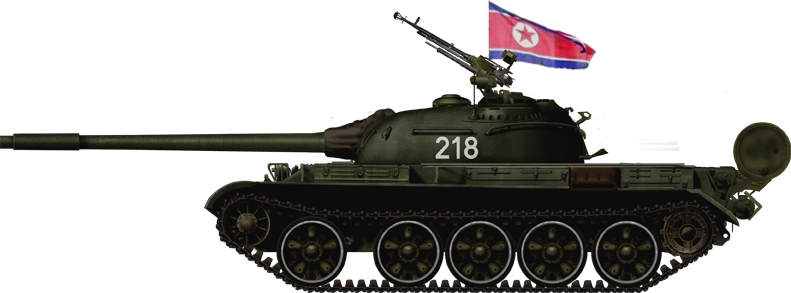
Modernized North Korean Type 59 in parade, with MANPADS “Igla” FCS, 1980s.

Chinese Type 59-I, in the 1970s. This version had an improved type 69 gun with a laser rangefinder, and other improvements.

Chinese Type 59-I, with rubber side skirts in the 1980s.

On the North Korean frontier, in winter camouflage.

Late Type 59-I, 1990.

Type 59T with its thermal sleeve, location unknown.

Pakistani Type 59-Is stationed at the government installation in Hayatabad near tribal areas, june, 30, 2011

Possibly Iranian Zafir-74 (standard T72Z upgrade for Type 59s) with the 105 mm M68 (Royal ordnance L-7), Slovenian FCS, upgraded engine and ERA.

Type 59-II (factory designation WZ-120B) in the 1980s, equipped with the Austrian-based L7 (Royal Ordinance) 105 mm gun.

Iraqi Type 59-II, 1991 first gulf war

Type 59 IIA (apparently without thermal sleeves), 1980s.

Chinese Type 59-IIA upgraded in the 1990s.

Upgraded Chinese Type 59 IIA with thermal sleeves and new FCS, 2000s.

Chinese Type 59G, the very latest version of the type, here in the Tanzanian army.
Type 69/79 MBTs (1969)
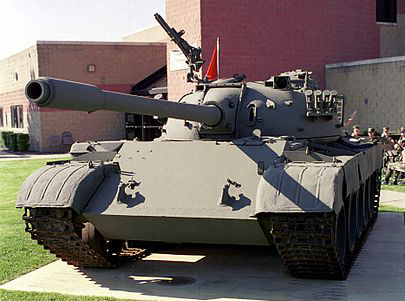
Unable to gain access to the technology of the latest Soviet tanks, like the T-62, the next generation of medium tanks nevertheless went ahead with the Type 69, falsely assimilated by some experts as a copy of the T-55. The Type 69 is frequently assimilated to the Type 79 and often the three types are mismatched. The Type 69 was designed from 1963 to 1974 by the No. 60 Research Institute to be an all-improved version of the Type 59, with a dual-axis stabilized 100 mm smoothbore gun, a new 580 hp engine and an IR search light, among other changes. However, in 1969, during the Sino-Soviet border conflict, a T-62 was captured, and served as a basis for a new wave of improvements. Therefore, the new tank was the first completely developed in China, although still with many Soviet-origin technologies, adapted to the Chinese needs. The Type 79 was a new version following the adoption of many western technologies. The first was mostly exported abroad. Both are still in service today, despite the arrival of new, improved models.

Type 69 MBT prototype of the P.L.A. 1974.
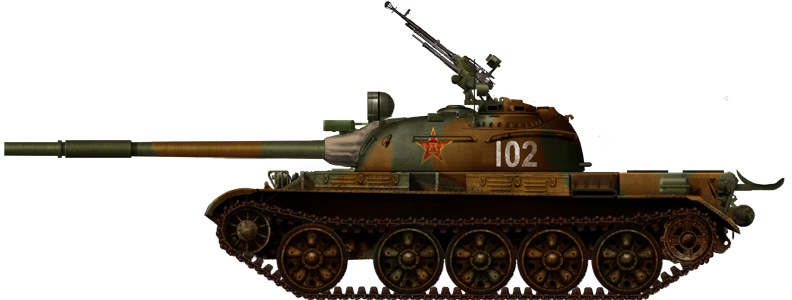
Type 69-I in Chinese service
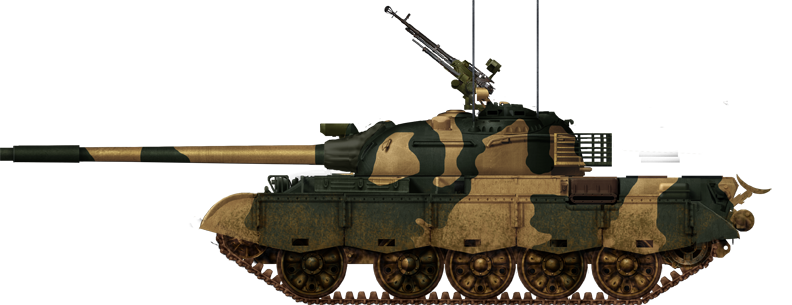
Type 69-II prototype. Notice the unusual camouflage.
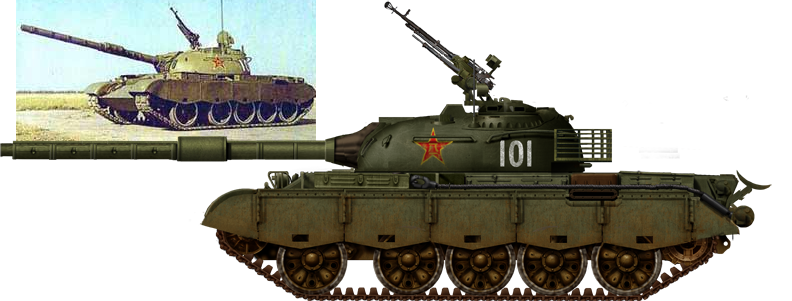
Type 69-III prototype, painted in full green livery.

Type 69-IIIb or late Type 79 in Chinese service, 1990s. Notice the Type 83 thermal sleeve
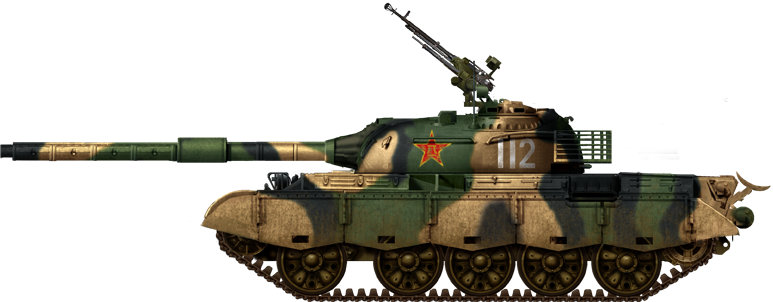
Chinese late Type 79 with a three tone camouflage, early 1990s

Bangladeshi Type 69-II

Bangladeshi Type 69-IIG Mk2, with ERA on the turret’s roof

Pakistani Type 79.
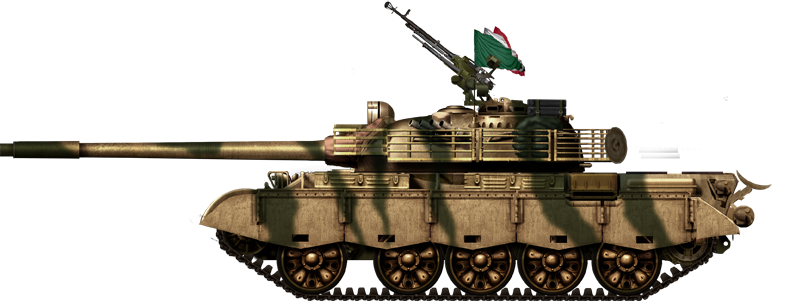
Thai Royal Army Type 69-II

Iraqi Type 69 QM in service with the Iraqi new army in 2007.

Iraqi Type 69 QM2 in 2003.
Type 80/88 MBTs (1980)
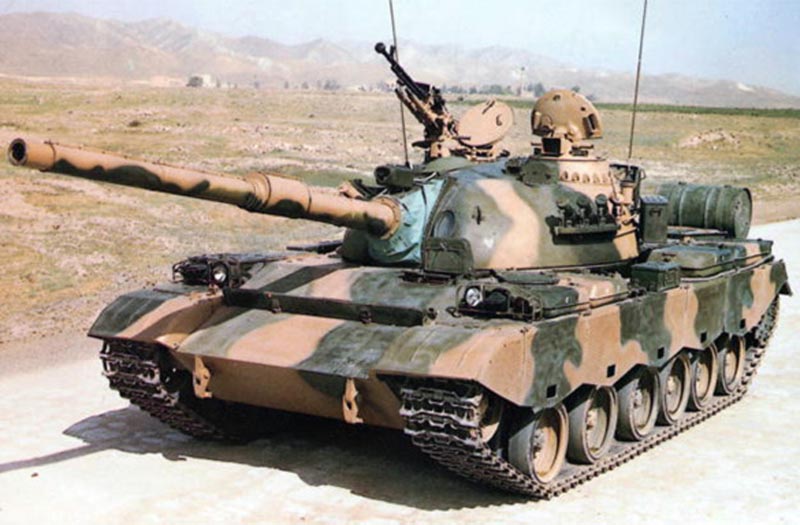
The Type 80 was the last T-54/55 inspired tank, based on the Type 79 but with even more Western technology due to the better relations with the West. The Type 69 officially failed to satisfy the Chinese requirements, so 617 Factory (now Inner-Mongolia First Machinery Group Company Ltd) was put in charge of integrating a new chassis with new wheel/track systems and reworked suspensions, an all welded turret, increased protection, a much more modern German 730 hp 1215OL-7BW diesel engine, a dual-axis stabilized light spot FCS and external laser rangefinder, with a Type 83 105 mm rifled gun, NATO-standard, licensed from Austria.

Early Type 80 MBT, without side skirts to show the drive-train. There is a gap between the second roadwheels and the four rear ones.
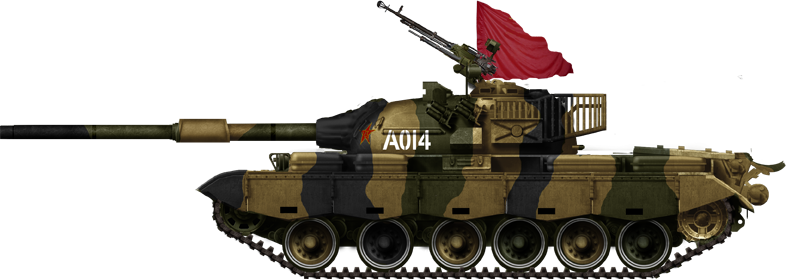
Type 80 in a parade in the early 1980s.

Type 80 with the standard three-tone camouflage (dark sand, olive green, dark grey).

Type 80B at the National day parade.

Type 80 with a three-tone camouflage (two tones of green).
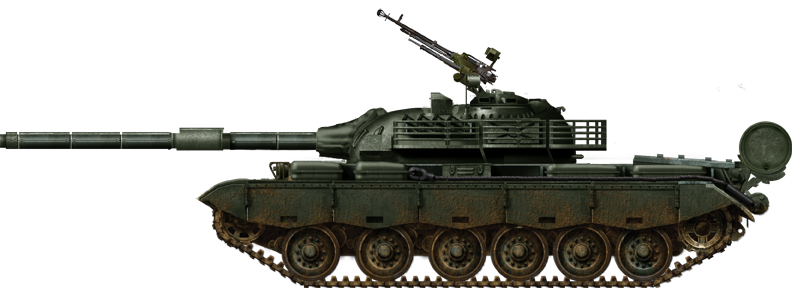
Type 80-II prototype (apparently) on trials, notice the unusual green livery and absence of external LRF

Type 80-II in the early 1990s with the external laser range finder

Type 88 MBT
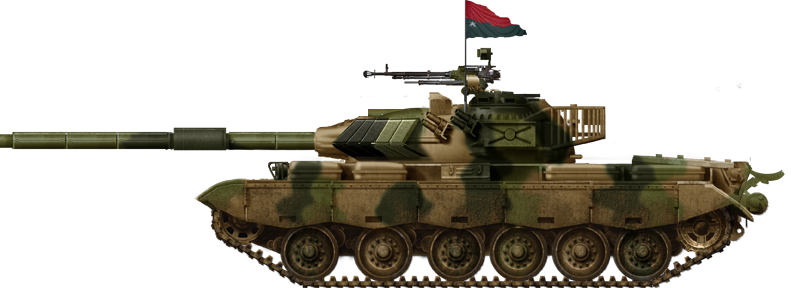
Myanmar army Type 88B.

Type 88A with a three-tone camouflage
Type 85 MBT (1985)
The Type 85 was built by Norinco most likely in association with the 201 Institute (now China North Vehicle Research Institute), and inspired by the T-72 as a few ex-Iraqi ones captured by Iran were purchased by China for examination. It was the first second generation Chinese tank, but still not satisfactory, not only compared to the T-72 but also most western tanks. Around 900 were built. The Type 88 was an attempt to radically upgrade the Type 80. It was created by the association of China’s 617 Factory (main contractor), 616 Factory, 477 Factory, and 201 Institute. It was still technically an offspring of the Type 80, however protection was heavily upgraded. It entered service in 1988, and production was stopped in 1995 after 400 to 500 were built.

Type 85 MBT, early production (1991)
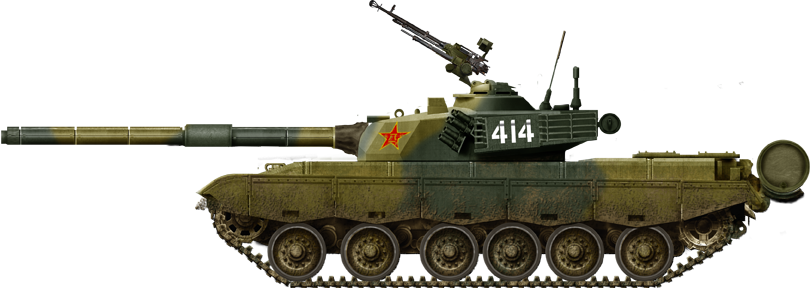
Type 85A or Type-85-I MBT, three-tone camouflage
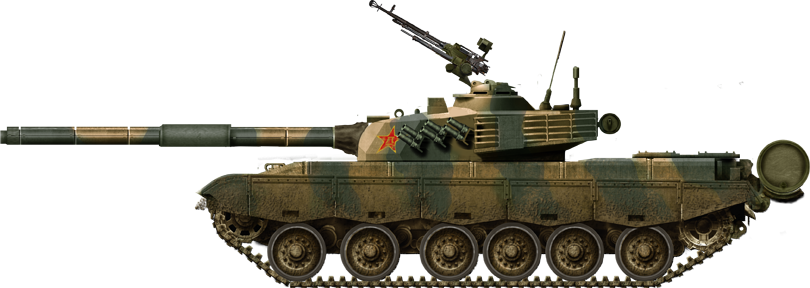
PLA’s Type 85-II or IIA

PLA’s Type 85-II or IIA

Pakistani Type 85-II AP

Chinese PLA Type 85-IIM ERA

Type 85.

Type 85-III MBT, With the IIM this model pioneered the new 125 mm smoothbore gun.
Light tanks
Type 62 Light tank
The Type 62 was basically a much lightened Type 59 used as a light tank for the Himalayan ranges. About 1500+ were produced in the 1960s. The Type 62 was also exported to Asia and Africa. Most have been modernized as the Type 62-I and Type 62G and withdrawn from service.
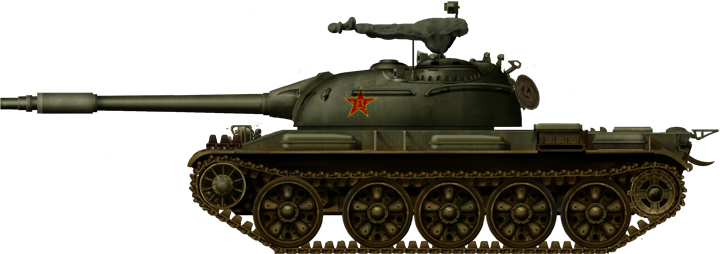
Type 62 of the early production in Southern China, 1963
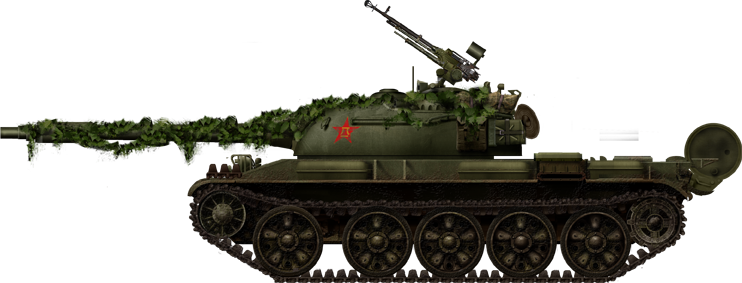
PLA Type 62 in Lạng Sơn, 55th or 42nd Corps, North Vietnam, Sino-Vietnamese war of 1979.
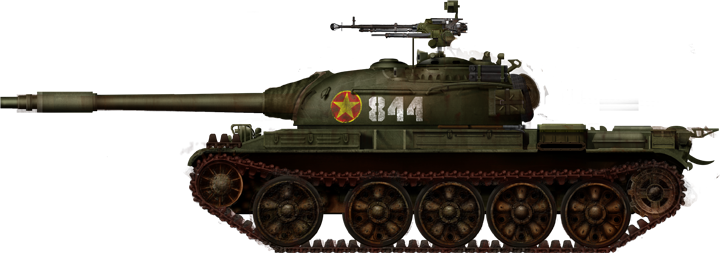
North Vietnamese Type 62, Têt offensive, 1968.
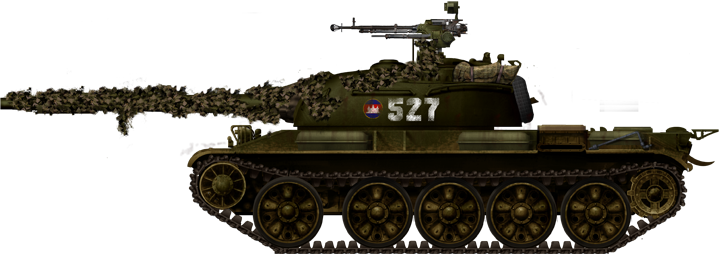
Cambodian Type 62.
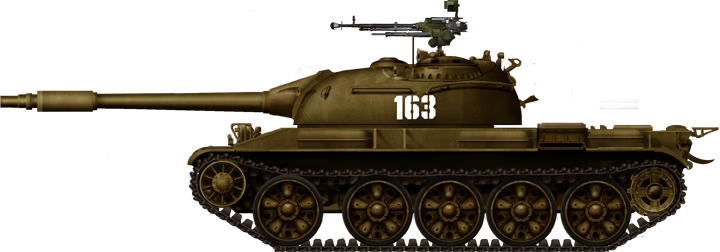
Type 62 from Laos (according to the China defence blog). Possibly inherited from the NVA forces.
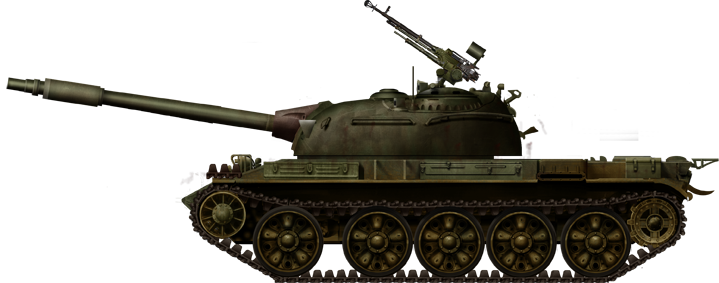
Congolese Type 62, apparently retaining its green livery, with no markings and no gun mantlet canvas protection.
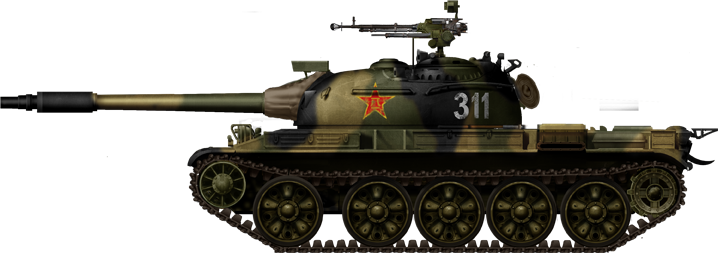
Type 62-I (early-production) in the early 1980s.
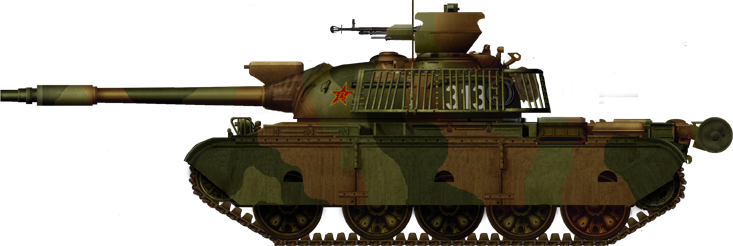
Type 62-I (late-production) in the 1990s.

Type 62 G in 2005 (saw in CCTV, possibly of the organic recce unit of the Guangzhou MR artillery regiment.
Type 63 light tank
A virtual copy of the Soviet PT-76, but with the turret from the Type 62. It was the main amphibious tank in service, superseded by the larger Type 63A in the 1990s.

Type 63
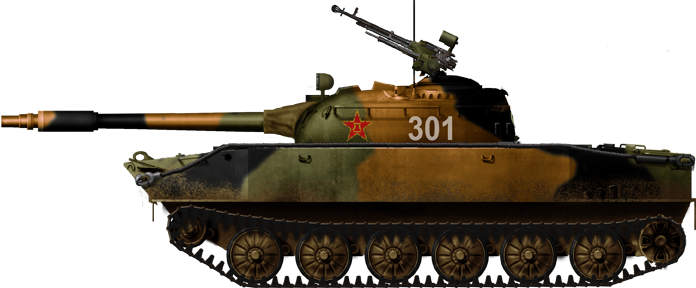
Camouflaged Type 63
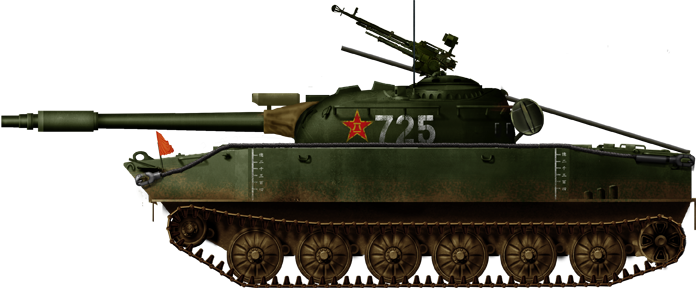
Type 63-II with the standard green livery, 1970s
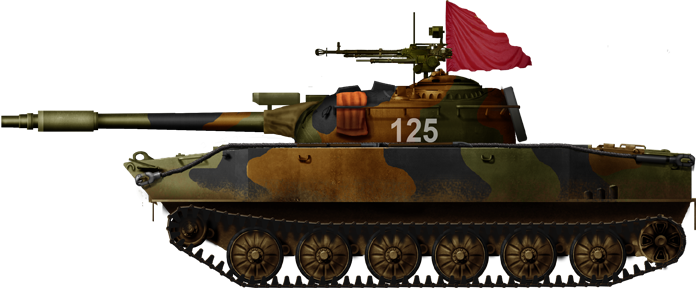
Camouflaged Type 63-II of the Chinese Marines, 1990s
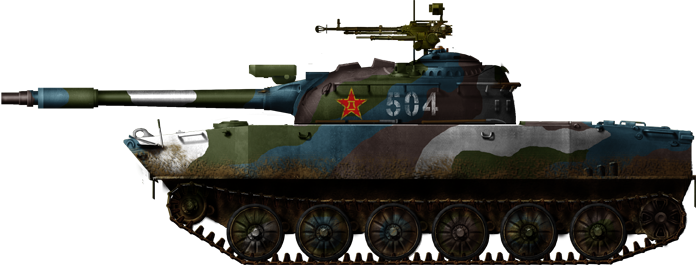
Another camouflaged Type 63-II now preserved and displayed at the Artillery & Aircraft park Minsk World, Shenzen.
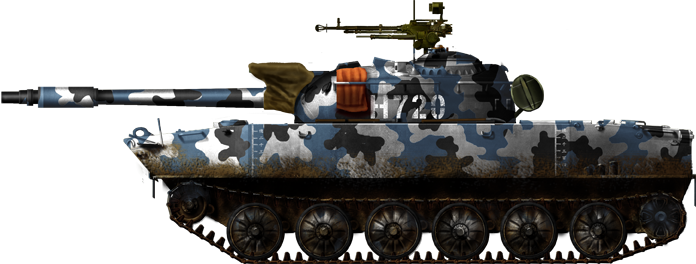
Chinese Marines Type 63-II with its impressive three-tone “cold tones” camouflage, 1990s
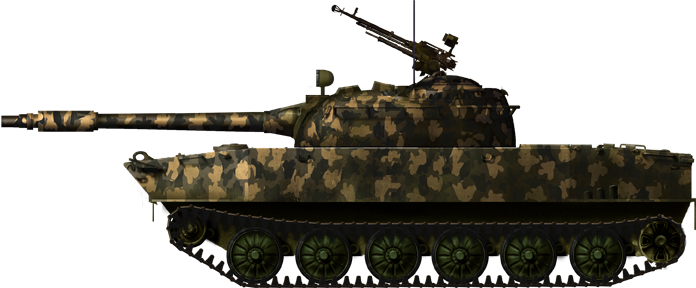
Tanzanian Type 63
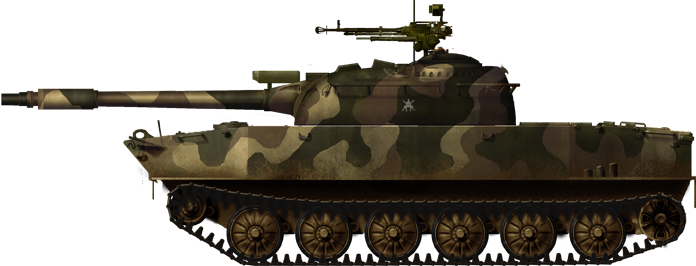
Burmese Type 63-II in Myanmar

Chinese PLA Type 63A, equipped with the Type 63G turret, the current version of this amphibious IFV.
Type 90 main battle tank

Type 90-I. This prototype solely intended for export to Pakistan in 1997 was equipped with a British Challenger Diesel coupled to the Leclerc transmission. However the project was wrecked by the arms embargo to Pakistan after the 1998 nuclear tests.

Type 90-II. This prototype pioneered a 100% Chinese 1000 hp powerplant. However the latter had difficulties in desertic/arid climates.

Type 90-IIM. This was a development also for export of the Type 90, this time equipped with an Ukrainian diesel also used on the T-80U.
Infantry Fighting Vehicles
Type 86 IFVs (1985)
The main Chinese IFV, derived from the Soviet BMP-1. Many were exported and several variants were also produced. China produced an estimated 3,000+ Type 86s. About 1,000 were enlisted as of 2009.
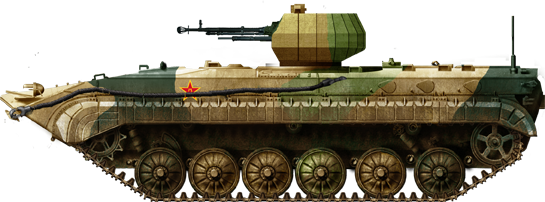
Type 86 APC
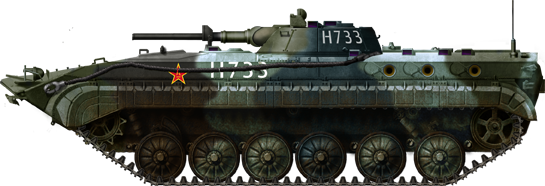
APC version
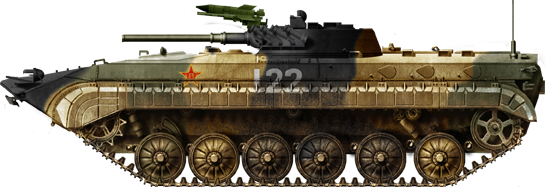
Regular army IFV
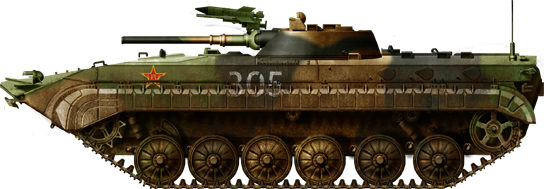
Chinese army IFV
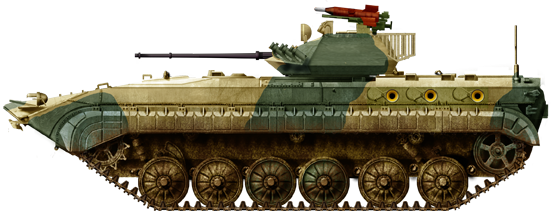
Chinese army IFV

Chinese Navy IFV (PLAN)
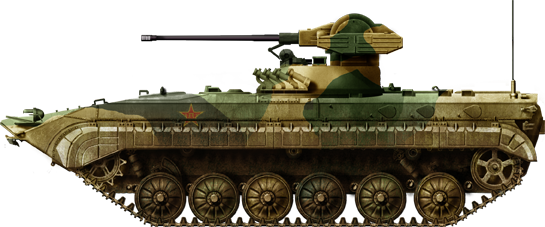
Type 86A

Type 86A amphibious version
Armoured personal carriers
Type 63 APC
The first tracked APC designed in China that saw mass production (perhaps over 8,000 built including exports) from the 1960s to the 1980s. It was declined into 19 variants and was armed, as standard, with the Type 54 12.7 mm (0.5 in) heavy machine gun. Criticized in the west (some were captured after the 1990 Iraq war), it showed poor ballistic protection due to dubious steel quality, but also a cramped troop compartment, low power-to-weight ratio, no NBC protection, no rear ramp, no anti-slip roof surfaces, nor inner spall-lining. It was nevertheless an export success due to its fairly low price.
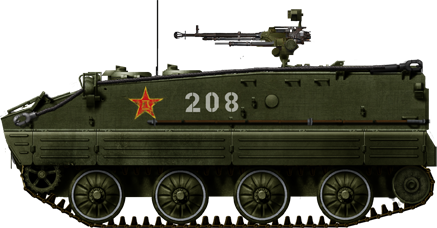
Type 63, early production vehicle
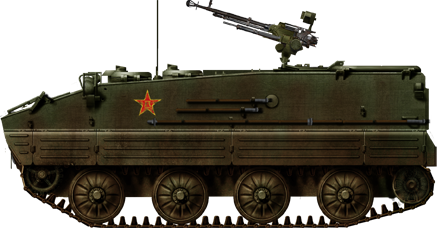
Type 63 APC, mid-production, 1970s
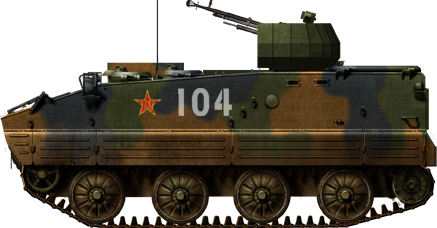
Chinese late Type 63-2 APC, 1980s.
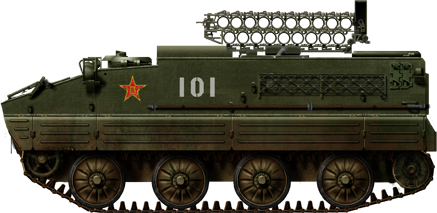
WZ-303 Multiple Rocket Launcher
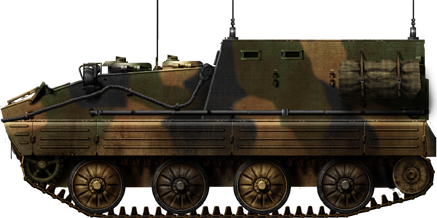
Chinese PLA WZ-701 command vehicle
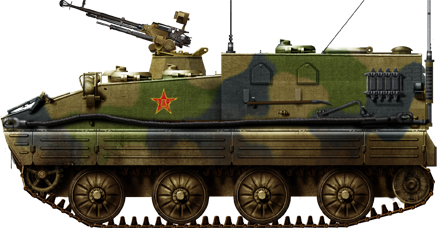
WZ-721 communication relay vehicle, with the ZZT-1 mast antenna at the rear
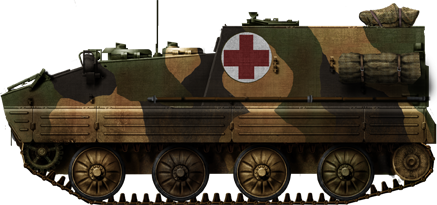
Chinese PLA WZ-750 Ambulance
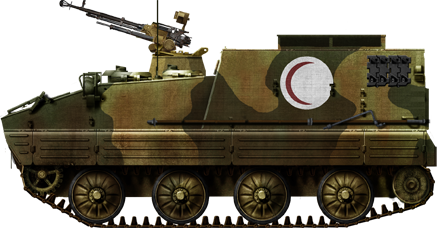
Iraqi YW-750 Ambulance APC, 1992. Ambulances were designated BTR-63-1 and the export versions had a 12.7mm Type 54 mounted at the TC station. One captured by the 203rd MI Battalion.
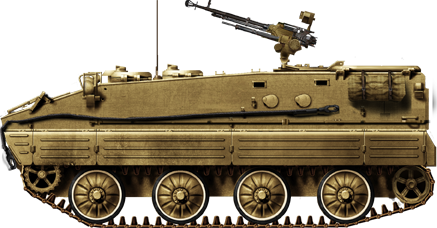
Iraqi Type 81 (YW-531) APC, Iran-Iraq war, fall 1980s. The YW-531C was designated locally BTR-63.
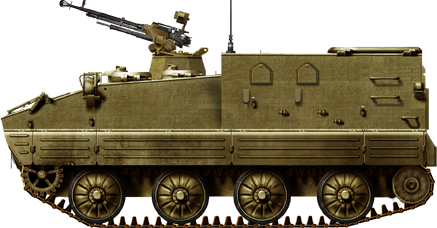
Iraqi WZ-701, 1991 gulf war
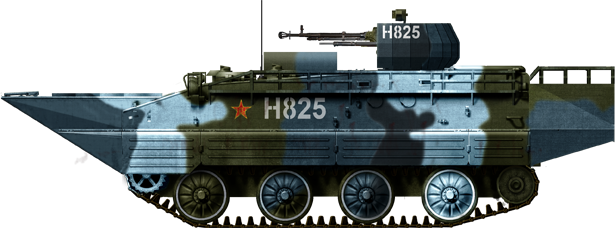
Chinese Marines Type 63C. The kit is made by two pontoon ends, which provides extra buoyancy as well as improving seaworthiness for amphibious operations.
Type 77 APC (1978)
Making good use of the Type 63 amphibious tank chassis, this Marine APC was not a copy of the BTR-50.
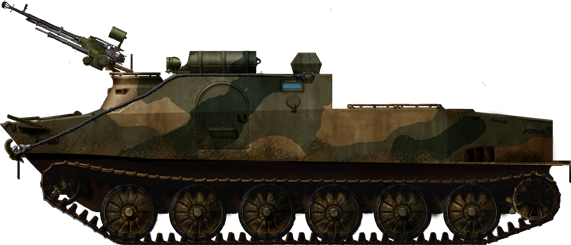
Type 77-2 AAPC in a regular Army pattern
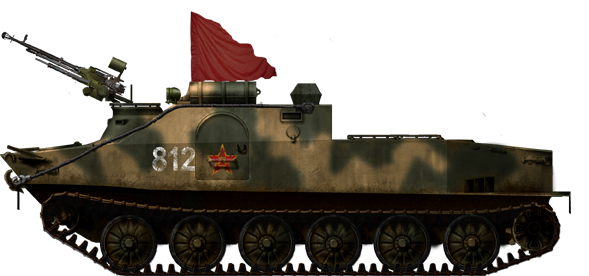
Type 77-2, without gun.
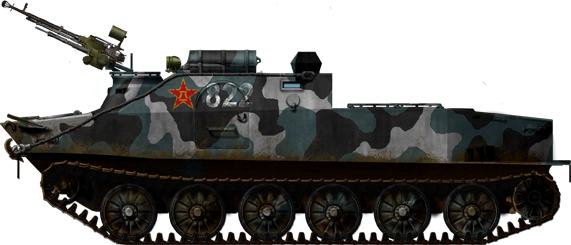
Type 77-2 of the Chinese Marines
Type 85/89 APC (1985)
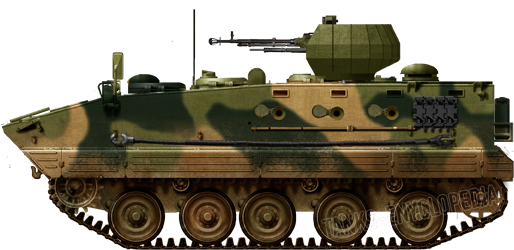
The regular Type 85 APC
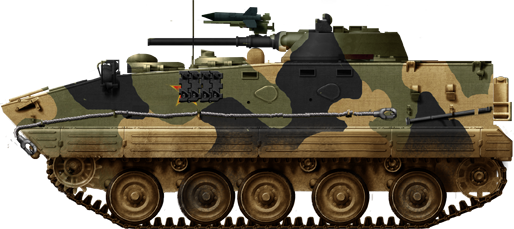
YW-309 IFV
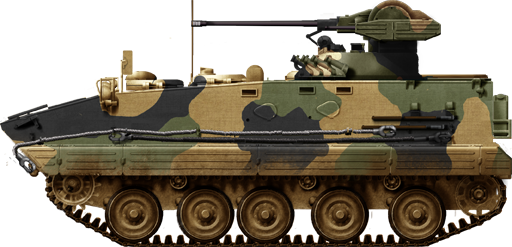
ZDS-90 IFV
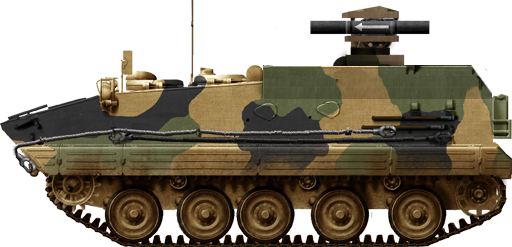
Type 85 missile tank destroyer armed with 4 HJ-8 ATGMs
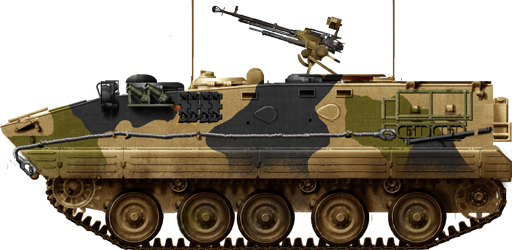
Type 85 Command Vehicle
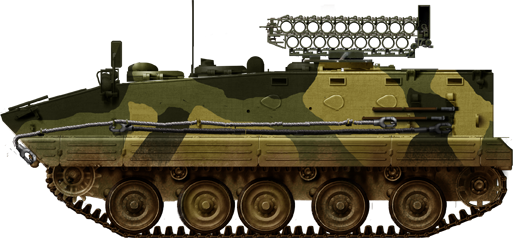
YW-306 self propelled rocker launcher
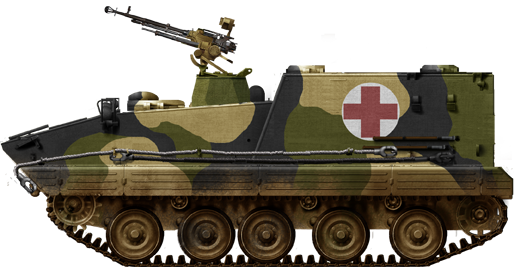
Type 85 Armored Ambulance
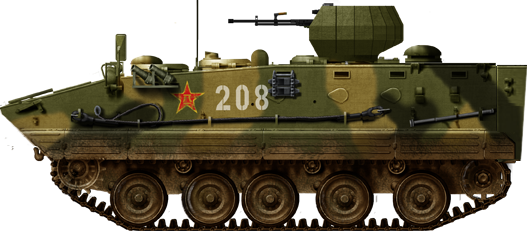
Early Type 89 APC
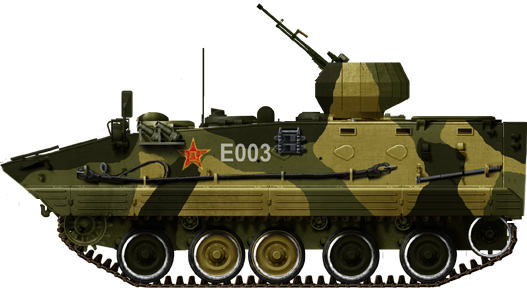
Type 89 at the Beijing parade
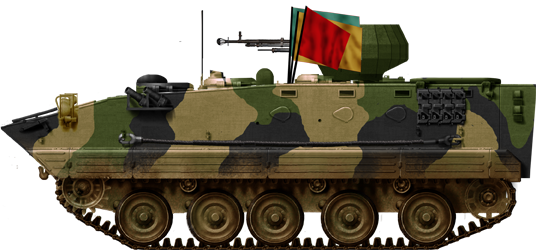
A Type 85 or 89 APC version in service in Sri Lanka
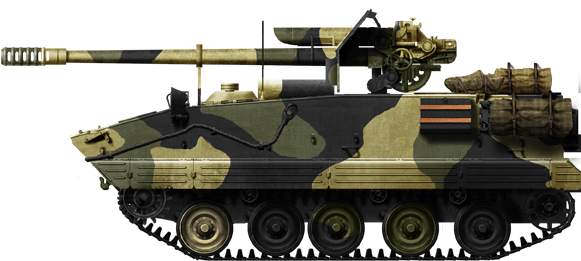
Type 85/Type 54-II or YW 531 H self-propelled 122 mm Howitzer
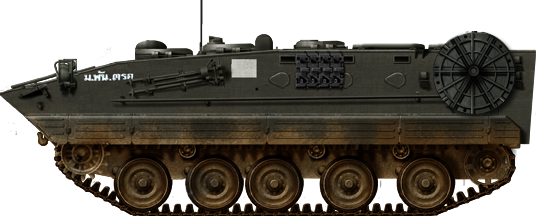
Thai Type 89

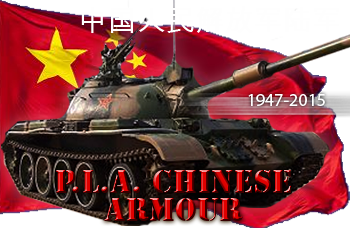
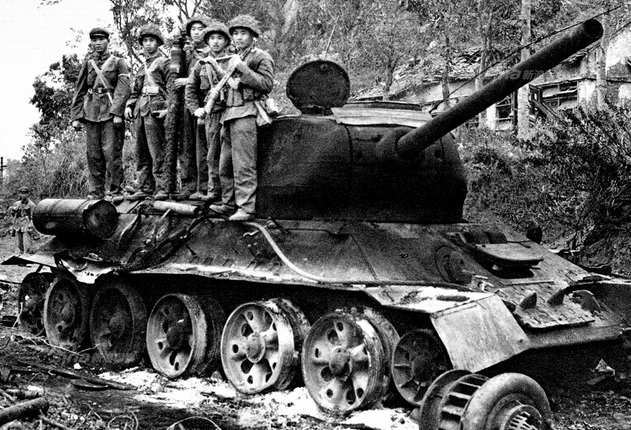
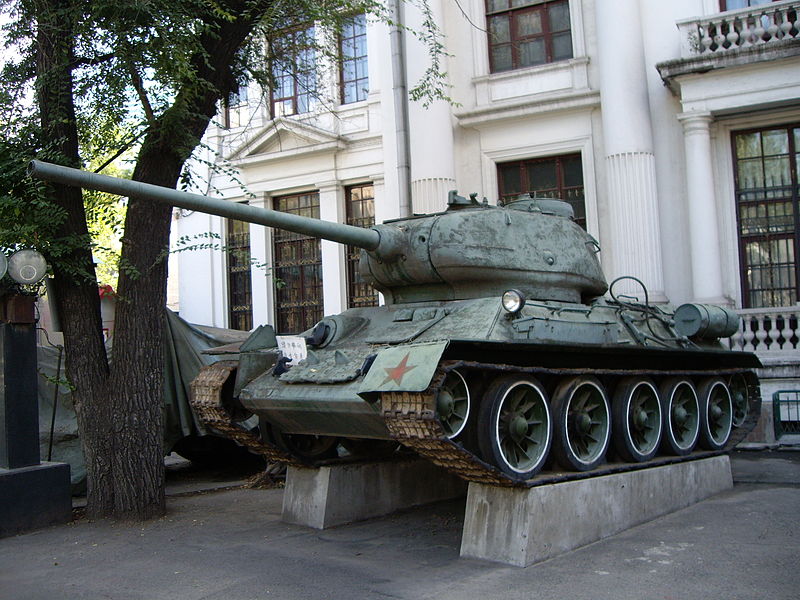
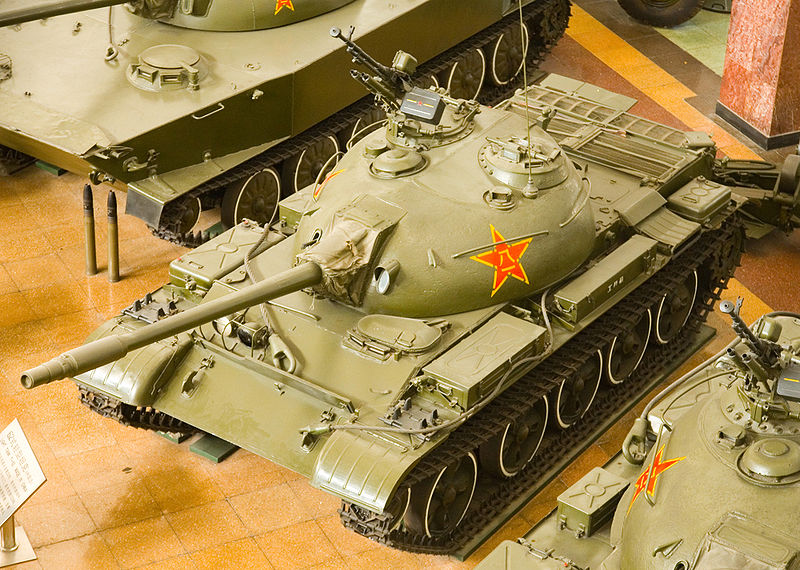
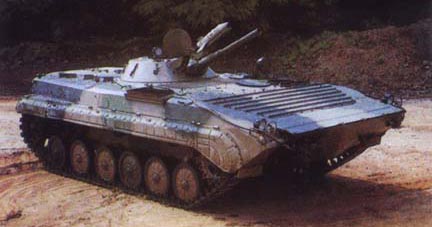
.jpg)
50 replies on “People’s Republic of China (Cold War)”
Sino-Indian War (1965)
This fast clash lasted only from 20 October to 21 November 1962,
Hí. Is the year correct. One should be wrong.
The first one was wrong. It has been corrected.
Thank you for your help!
Hi. Page is great, but too many Chinese in total: 🙂
385 male and 363 billion females
Please continue the encyclopedia!!!
That was an awesome typo :))
Thank you for your help!
So approx 1 billion women to every man? I gotta head to China soon!
Love your site, keep up the good work 🙂
The first photo in think is wrong. The tank what on the photo isn’t Type 59, it Type 62 light tank.
Hi Anderson,
Can you precise the link of the image, please ?
(like this one: https://www.tanks-encyclopedia.com/coldwar/China/photos/Type59_PLA_destroyed_Cao_Bang_1979.jpg)
thanks !
The Type 62 have double row track teeth while Type 59 have single only(Such as Soviet’s T-54). And Type 62’s gun barrel is obviously different from Type 59’s too.
This is Type 62, please be attention to it’s track: http://att.bbs.duowan.com/forum/201412/24/102346l8ccc8ugxgxc8jx8.jpg
This is Type 59(with 100mm rifled gun): http://himg2.huanqiu.com/attachment2010/2015/0914/20150914103910943.jpg
It‘s great page.I even can’t find it in Chinese
This is the best I’ve ever seen about tanks website, this is a great job.
and where is 7.62cm Pak 36 (r) Auf 5t Zugkraftwagen Sd Kfz.6/3?
Thanks !
That’s a difficult subject however. The 7.62cm Pak 36 (r) Auf 5t Zugkraftwagen Sd Kfz.6/3 is one of the models planned for schedule, based on this half-tracked which will go to the ww2 vehicles section. They will come in time.
It would be nice if u add article about Type 64
The Type 64 is part of the ROCA future page, completely separated from this one. We just did a survey and list of all models, starting with the 1930s.
Acturally the supposed “ROC” is a part of China,so Type 64 shoud not talk seprately.:)
Wait… I think the Destroyed Chinese T-34/85, Korean War picture is the same as the Wrecked North Korean T-34/85 shot at the bridge south of Suwon (Korean war) You mind taking a look.
Thanks
how about wz 1224 ?
Nice page. However some suggests that the type 58 was not simply a T34-85, this designation only refers to a small number of modified T34-85’s with additions like loader’s cupola, turret-top machine guns mount and V-shape armor plate on turret roof, etc. The type 58’s were actually built in China, those T34-85’s received from the soviet were not under the designation.
As for the picture at Lang Son I believe it was a Vietnamese T34-85 destroyed by the PLA, with PLA soldiers standing on it (type 74 uniforms, type 56 AKs and chest-rigs). The tank in the picture lacked any external trait of a type 58 (eg. cupola), and it was quite certain that no Chinese T34-85 or type 58 were operated by the PLA during the ’79 conflict.
http://ln.people.com.cn/n/2015/0206/c353958-23810125.html
Type 58 destroyed at Lang Son
It’s actually a Vietnamese T34-85 destroyed by the PLA.
The photo taken by Yongan Li(李永安)
Actually the T-34-85 and those upgraded tanks served as the main force in PLA until the 80s; some of them served in the Marines in the ’90s, and even stayed in the reserve/training forces until the 2000s. While T-34-85s were deployed in the ’79 self-defence war as reserve forces, none were destroyed or damaged.
Under the Type 59 section it says the type 58 was the most numerous tank i’m guessing that’s not right
Thanks, its been corrected
TE Moderator
As seen that there’s not a distinct page for Taiwan (or the Republic of China), would there be any chance to include Taiwanese tanks used in the taiwan era of the ROC in this page? They have some interesting variants of American tanks in service as well.
Indeed there is no Taiwan tanks page yet. But it should come soon or later. Also, we already treated most of these early tanks in a poster: Like this one https://ih1.redbubble.net/image.397539324.9150/flat,1000×1000,075,f.u1.jpg. As for PLA, there are a lot more articles waiting to be done: https://ih0.redbubble.net/image.378768013.1947/flat,1000×1000,075,f.u1.jpg
Taiwan should never be regarded as an sovereign country. Or you can post those pages under the PRC section, combining the PLA tanks.
We will probably treat Taiwan separately, as it is for all intents and purposes a different country with a different military (except for recognition).
I’m sorry,there is not any PLA organnization called “8th Army”.
only several “army corp”s tool part in the 1979 war,like the 43rd,54th and other corps.
I love tanks , amazing website.
hello!I really like this website about Chinese tanks, but I have a question, I cannot find the page about the type 86 ifv anymore. It will be great is you brought it back. overall, this website is absolutely awesome and the pages about Chinese tanks are the best.
China did not lose any T-34-85 or Type 58(upgrade kit) in Vietnam during ‘79 to ‘88. Although PLA did suffer a great loss of ZTQ-1962(Type 62 LT) due to its poor armor, PLA armored units has achieved great trophies wiz its 62&59 due to the poor courage, poor command skills(according to PLA generals) and the lack of anti-tank weapons.
Also, according to Chinese military documents about the Korean War, the story of tank No.215 (commander Yang Aru杨阿如) does exist, although it might have been exaggerated. And about the picture on the section of Korean war, Chinese tanks have never used such painting method with which the number can be painted on the wrong direction. Also due to the lack of T-34s, China PVA seldom used its tanks. So may I put forward my doubt that the picture of “destroyed Chinese T-34” might be false? Or it might be a DPRK T-34 lost in 1950?
May I also ask that why is the ZBD-86(Type 86 IFV) page missing? It has an important impact on PLA, for it is the first IFV of PLA.
Also, Taiwan should never be referred to as an sovereign country. According to the joint announcement of the diplomatic relationship between USA and PRC, Taiwan is an important part of PRC and should never be separated from PRC. Maybe you can put the Type 64 LT under the title of Taiwan(China) in the page of PRC. And there are also some unique tanks you can add under the Taiwan(China) section, such as CM-11/12 or M48H, and the M41D. Thanks a lot, and I appreciate your awesome page of Chinese tanks.
Where’s the Type 86?
While this website is quite awesome , I shall point out that it still has many drawbacks.
First, most contents about Warsaw-Pact and communist countries are mainly based on western intelligence and bias, such as those about Chinese and DPRK tanks, which, when compared to original information, are confusing and incorrect.
(Due to the lack of reply section under the North Korean section, I shall leave some corrections under the PLA section.
First, DPRK has no tanks named “M2002” or “Pokpung-ho”, which are names used by ROK and US intelligence. The real name is “Seougun-Ho”, according to a Chinese military journalist who has been informed of DPRK tanks. The tank is equipped with an bored-out 125mm gun based on 2A20, without any autoloader, therefore is not a copy of D-81/2A46 variants.
Second, the name of “Chonma-Ho X(I-V)” is also false. The actual names are like “Chonma-Ho 76” (name of NK production variant of T-62 in 1976) or later variants of improved T-62. They are simply named after “Chonma-Ho +year of production”.
Due to the fact that Western introduction of NK tanks are mostly based on NATO/US intelligence and bias, I strongly suppose that the contents should be improved with more accurate info from PRC and DPRK.)
Second, when it comes to Chinese tanks, still there are many speculations of Western intelligence. For example, Type 86 IFV (BMP-1) is based on examples from Egypt in 1979. And the ZTZ-80(WZ-122-3) was never serially produced; instead, it was a testbed for the ZTZ-88 series. Also, no PLA troops were equipped with ZTZ-85 (Storm series), though some may have used it for assessment.
As a Chinese citizen and enthusiast, while I am quite amazed at the richness and diversity of various tank data, I suggest that all contents should be inspected, especially of those “hostile” or “ex-hostile”countries of NATO countries, in order to make them precise and fair.
Thank you for this information. All the Cold War and Modern Chinese and North Korean article have already been marked for rewriting, you can see that on our Public Suggestion List
https://docs.google.com/spreadsheets/d/1p0Ll9TITGDiF9_fdS-tv1797JBs0_-pB70ReE_kIRkE/edit#gid=1911430820
We will indeed also use local sources were available, but they should not always be considered credible. Both are authoritarian states that have repeatedly show to have little interest in offering true information publicly
Thanks for your reply.
While it is reasonable for you to query the local information about Chinese and DPRK tanks, I shall point out that, for DPRK, the deep hostility between DPRK and Western countries and the barrier of information led to the lack of original info. But for China, in the last two decades, many original documents of Chinese domestic weapons and war history has been declassified and spread on the Internet. Why should you judge the tanks according to Western intelligence which is obviously based on speculations and even bias of ideology and hostility, with more accurate Chinese and DPRK original source available?
While it is possible for DPRK to conceal its real situation of armored troops and equipments, China has no need to do so, because some of these equipments are considered obsolete, such as ZTZ-59 series and ZTZ-88; while others have no need to be concealed from the public, such as the ZTZ-99 v1 and v2. And a more direct question: how could westerners acquire such precise number of production and details of their design? Some information on your website cannot be confirmed or may be false at first, such as the strange “3000+ Type 80 produced”, the non-existent use of DU rounds, and the incompatible information about Type 96/99 tanks.
In your reply, you mentioned that China and DPRK are “authoritarian states” and “have little interest in offering true information publicly”. This is an obvious expression of ideological hostility and discrimination. Based on the western ideology of “freedom” and “democracy”, which claimed tens of millions of lives in China(KMT era and 1989), ex-USSR, DPRK, Vietnam and in Arab states,and caused chaos and violence in HK China since 2019, you can define them as authoritarian or “WICKED” states, but for Chinese and DPRK ordinary people it is also quite natural for them to define you as imperialism states or even FACIST and racist extremists. Therefore I shall suggest that you should minimize those information with political or “human rights” opinion and BIAS on your website which, as the most comprehensive online-museum ever, should be as object and impartial as possible.
And also, in China it is quite easy to acquire accurate information of its own equipments. There are various sources of information like online forums and domestic “wikipedia”, with CCTV official military report available. Unfortunately these websites has been blocked by US and some EU countries, therefore making it impossible to acquire domestic information.
And how can you define the Chinese information “unreliable”? As far as I am concerned, China definitely has no need to exaggerate its performance of combat equipment. The catastrophic result of exaggeration and unreliable propaganda has claimed the lives of 30 million Chinese citizens between 1960 and 1962, due to the “Great Leap Forward” movement and the famine it caused.
Also, China does not need to conceal the information about the armored vehicles. Unlike the WWII and the following partial wars, modern warfare relies heavily on air and naval forces with informationalized technology. The role of tanks are heavily reduced, and without generational difference, the development of tanks are nearly unnecessary in the 21st century. And China also intends to inspire popular feelings with the propaganda of advanced tanks like ZTZ-99, especially in the ’90s and ’00s, when anti-government extremists and vandals supported by hostile countries discredit the country and conduct violenct acts.
As a normal PRC citizen, I feel worried with the increase in bias and reactionary words by foreign-supported anti-social people, and the emergence of another Cold War between the East and the West. And the only way to prevent uncontrollable disasters from happening is to eliminate the hostility between the people, which is apparently caused by political and “human rights” propaganda (by the way, NATO countries have used human rights to stir the students and vandals to disrupt social order or even murder policemen and military servicemen in China and Ukraine and other countries). I hope that with the help from your site, prejudice and discrimination could be reduced and eventually eliminated.
And when it comes to the results of wars and conflicts, I suggest that you should judge the results with multiple reports. For example, when it comes to the Sino-Vietnamese Conflicts, apparently the results on this site came from Western and Vietnamese report. But after analyzing the result, I found it ridiculous for Vietnam to claim victory: China has achieved its strategic goal, that is, to cause heavy losses on the enemies, and to pin down the hostile country from conducting aggression on Cambodia and China; on the other hand, the 10-year war hit the Vietnamese army and society heavily, causing a significant decline of economy, and prevented it from creating threats to China.
One reason why the reports of casualties differs greatly from each other is that both sides intends to use it as a tool for propaganda. But as the third party, western countries have no precise way to make conclusions, therefore the so-called “objective” western report may be influenced by the propaganda from either side, or even bias of racism and hostility.
And the reports publicized by Western governments are sometimes considered false. For example, the overall conclusion of casualties of US marine corps 1st division during the battle of Chosin Reservoir in Dec.1950 doesn’t even correspond to the numbers of evacuation flights of the temporary airfield of 1st division. And the method in which US estimate the loss of enemy army is unreliable, which is acknowledged in the book The Coldest Winter.
Actually the actual information about North Korean armored vehicles is rare. But the Pyongyang Military museum has opened its area of local armored vehicles in 2013, and foreign tourists can visit there after attending tour groups in China.
There are some prototypes which are not included. Maybe you can add the 122-X projects and the WZ-132.
The writer is careless on the Chinese-Vietnamese conflict, in fact Vietnam endured heavy losses with China at a lot lower. The second picture actually shows a Vietnamese T-34-85 destroyed by the PLA, instead of Type 58 destroyed by the Vietnamese. Plus the Type 58 didn’t see such long service in the PLA.
I don’t see the “number215” story as fake(for now),because the destroyed US tanks were NOT M46 Pattons,but M26 Persings,as the “215”commandor Yang A’Ru claimed himself.
That makes much more sense,but unfortunately I don’t have any resources at this time. Hope that you guys can search a little more,and improve your article.
Otherwise,you have done a lot of fantastic works,and this article about CPLA T-34s fills much of my confusion. Hope you can make this website better and better!
If it is possible for me, a normal tank enthusiast and a college student in China, to provide help and original files for you or even submit articles to you, I would like to ask your email address for further communication. Thanks!
Hello enthusiast,
We have already communicated on email and sent you to our Chinese guy.
But here is our email again: [email protected]
It is rather intriguing to look back on your page and comment on Chinese propaganda and documentary one year later, under the global situation now.
Please forgive me for mentioning politics on your site, but it is you who have started and kept discrediting the Chinese Communists and the Chinese people led by them and also DPRK, a country suffering from US sanctions and military menace for decades, and boasting the so-called freedom which has been proved useless in the states which US brought them “freedom and democracy” and murdered millions of people there like the Australian Facists.
First, you have portrayed the Chinese government under the CPC’s leadership as “an authoritarian state that has repeatedly showed little interest in releasing true information publicly”, which is a great insult and a good joke when we compare the actions taken by Chinese and Western governments during the COVID-19 pandemic.
Contrary to your words, the Chinese government and most cities and provinces in China kept releasing the number of newly-infected patients and those who passed away since the outbreak of the virus. However, the propaganda of our state media, or even just ordinary medical workers and policemen, has been recognized as fake and intentional news by those who were deeply brainwashed with Western ideology.
But however, when it comes to the data of Chinese armored equipment,everyone could understand your intention, that is, to steal classified information from those who have little sense of confidentiality, just like what US/KMT spies did in the ’90s–stealing the blueprints of Chinese DF-31 missile, and the plans of PLA’s action to liberate Taiwan.
Just like the recent incident in December 2020– some data processors of the game War Thunder asked for the exact technical data of the Chinese phase-2 APFSDS on Chinese website and received not only domestic ones, but also export ones. Those who either intentionally or accidentally leaked the data were arrested shortly afterwards, and the Russian data processor was found to be a spy disguised as a worker of the game company Gaijin. Given that the APFSDS phase-2 is still in service with the PLA, such acts could be serious enough to put those traitors in jail or even execute them under war conditions.
You can criticize the Chinese government for keeping those files secret, but it should be recognized as a natural act given that there are little files about US M829A3/A4 APFSDS rounds on the internet.
By the way, it is quite strange to see that some passages about Chinese armor (especially the page of modern Chinese armor has been entirely removed for months) have disappeared from your site after some time.
I suggest that, instead of asking Chinese web users to provide you with those files and documents, maybe it is a good idea for you to search and watch CCTV and online military reports thoroughly, or just visit the Chinese Tank Museum (or the Chinese Ground Forces museum after 2025, which is now closed) to inspect those tanks by yourselves.
What do u think about the WZ-121 from WoT since the real WZ-121 is the Type69 and it have shorter hull and a 100mm/105mm instead of a fictional 122mm
I found an image about the development of Chinese tanks before, it has some basic information, e.g. production date, usage, etc.
the image seems to be a tech-tree with some basic info about the development history and changes
China basically takes every soviet tank, adopts it as their own, and says its completely original. lol.
the sino-us jaguar is a point of interest, known details are very limited
I never seen any Type-62 in the Vietnam War. NVA never got Type-62 from China, are you wrong? Or is this just an example?